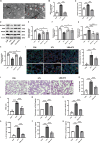Ferritinophagy mediated by the AMPK/ULK1 pathway is involved in ferroptosis subsequent to ventilator-induced lung injury
- PMID: 39719634
- PMCID: PMC11669221
- DOI: 10.1186/s12931-024-03076-7
Ferritinophagy mediated by the AMPK/ULK1 pathway is involved in ferroptosis subsequent to ventilator-induced lung injury
Abstract
Mechanical ventilation (MV) remains a cornerstone of critical care; however, its prolonged application can exacerbate lung injury, leading to ventilator-induced lung injury (VILI). Although previous studies have implicated ferroptosis in the pathogenesis of VILI, the underlying mechanisms remain unclear. This study investigated the roles of ferritinophagy in ferroptosis subsequent to VILI. Using C57BL/6J mice and MLE-12 cells, we established both in vivo and in vitro models of VILI and cyclic stretching (CS)-induced cellular injury. We assessed lung injury and the biomarkers of ferroptosis and ferritinophagy, after appropriate pretreatments. This study demonstrated that high tidal volumes (HTV) for 4 h enhanced the sensitivity to ferroptosis in both models, evidenced by increased intracellular iron levels, lipid peroxidation and cell death, which can be mitigated by ferrostatin-1 treatment. Notably, nuclear receptor coactivator 4 (NCOA4)-mediated ferritinophagy contributed to ferroptosis in VILI. Inhibition of autophagy with 3-methyladenine or NCOA4 knockdown decreased intracellular Fe2+ levels and inhibited lipid peroxidation, thereby attenuating CS-induced lung injury. Furthermore, it has also been observed that the AMPK/ULK1 axis can trigger ferritinophagy in VILI. Collectively, our study indicated that MV can induce ferroptosis by promoting NCOA4-dependent ferritinophagy, which could be a novel therapeutic target for the prevention and treatment of VILI.
Keywords: AMPK-ULK1 axis; Ferritinophagy; Ferroptosis; Ventilation-induced lung injury.
© 2024. The Author(s).
Conflict of interest statement
Declarations. Ethics approval: Animal studies were reviewed and approved by the Institutional Animal Care and Use Committee of Guangxi Medical University Cancer Hospital. Consent to participate: Not applicable. Competing interests: The authors declare no competing interests.
Figures





Similar articles
-
STAT3 signaling promotes cardiac injury by upregulating NCOA4-mediated ferritinophagy and ferroptosis in high-fat-diet fed mice.Free Radic Biol Med. 2023 May 20;201:111-125. doi: 10.1016/j.freeradbiomed.2023.03.003. Epub 2023 Mar 20. Free Radic Biol Med. 2023. PMID: 36940731
-
Ferritinophagy is involved in the zinc oxide nanoparticles-induced ferroptosis of vascular endothelial cells.Autophagy. 2021 Dec;17(12):4266-4285. doi: 10.1080/15548627.2021.1911016. Epub 2021 Apr 12. Autophagy. 2021. PMID: 33843441 Free PMC article.
-
KA-mediated excitotoxicity induces neuronal ferroptosis through activation of ferritinophagy.CNS Neurosci Ther. 2024 Sep;30(9):e70054. doi: 10.1111/cns.70054. CNS Neurosci Ther. 2024. PMID: 39306799 Free PMC article.
-
Ferritinophagy: A novel insight into the double-edged sword in ferritinophagy-ferroptosis axis and human diseases.Cell Prolif. 2024 Jul;57(7):e13621. doi: 10.1111/cpr.13621. Epub 2024 Feb 23. Cell Prolif. 2024. PMID: 38389491 Free PMC article. Review.
-
The Role of NCOA4-Mediated Ferritinophagy in Ferroptosis.Adv Exp Med Biol. 2021;1301:41-57. doi: 10.1007/978-3-030-62026-4_4. Adv Exp Med Biol. 2021. PMID: 34370287 Review.
Cited by
-
Prepubertal Exposure to Tris(2-chloroethyl) Phosphate Disrupts Blood-Testis Barrier Integrity via Ferritinophagy-Mediated Ferroptosis.Toxics. 2025 Apr 8;13(4):285. doi: 10.3390/toxics13040285. Toxics. 2025. PMID: 40278601 Free PMC article.
References
-
- Bellani G, Laffey JG, Pham T, Fan E, Brochard L, Esteban A, Gattinoni L, van Haren F, Larsson A, McAuley DF, et al. Epidemiology, patterns of Care, and mortality for patients with Acute Respiratory Distress Syndrome in Intensive Care Units in 50 countries. JAMA. 2016;315:788–800. - PubMed
-
- Slutsky AS, Ranieri VM. Ventilator-induced lung injury. N Engl J Med. 2013;369:2126–36. - PubMed
MeSH terms
Substances
Grants and funding
- YCSW2024257/Innovation Project of Guangxi Graduate Education
- YQJ2022-4/Youth Program of Scientific Research Foundation of Guangxi Medical Cancer Hospital
- YQJ2023-4/Youth Program of Scientific Research Foundation of Guangxi Medical Cancer Hospital
- GXMUYSF202305/Youth Science Foundation of Guangxi Medical University
- 82100091/The National Natural Science Foundation of China
LinkOut - more resources
Full Text Sources

